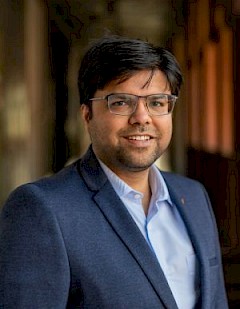Biological and Life Sciences

Ashim Rai
Assistant Professor
PhD (Tata Institute of Fundamental Research)
+91.7303035012
Research Interests: Cytoskeleton, Single-molecule Biophysics, FRET Biosensors, DNA Origami
Profile
Professor Ashim Rai did his PhD in 2016 from TIFR, Mumbai in Professor Roop Mallik’s lab where he used in vitro reconstitution and force spectroscopy methods to understand the mechanisms of phagosome transport. His research revealed a unique mechanism of dynein motor clustering in lipid rafts and highlighted the disruption of dynein clustering as a mode of pathogen survival in cells (Rai et al., Cell, 2016). For his postdoctoral work, Professor Rai moved to University of Minnesota in 2016 where he studied mechanisms of motor regulation by adaptor proteins in Professor Sivaraj Sivaramakrishnan’s group. Professor Rai developed a method to reconstitute a minimal actin cortex on supported lipid bilayers and used it to show the impact of motor transport on the underlying cytoskeletal network. His work showed that myosin VI motor is regulated by a dynamic interaction with the adaptor protein Dab2 to allow cargo transport through a dense actin cortex (Rai et al., JBC, 2021). In another study, Professor Rai used single-molecule methods to show that the adaptor protein GIPC tunes the stiffness of the cargo-motor linkage to drive fast cargo transport (Rai et al., JBC,2022). In 2020, Professor Rai moved to The Scripps Research Institute, California in Professor Danielle Grotjahn’s lab where he used the cutting-edge imaging technology of cryo electron tomography to study changes in mitochondrial structure during cell death.
At Ahmedabad University, Professor Rai’s research is directed towards building single-molecule tools to study the molecular mimicry mechanisms used by pathogenic factors to hijack the host cytoskeletal machinery. He plans to study cytoskeletal remodeling using single-molecule reconstitution, conformational dynamics of cytoskeletal factors using FRET biosensors and to build DNA origami-based platforms to specifically target interaction of pathogenic factors with host cytoskeleton inside cells.
Research
My research interests over the years has spanned the entire gamut of cytoskeletal biology ranging from cytoskeletal transport to cytoskeletal remodeling. It can be broadly divided into the following themes:
- How does a cellular cargo self-regulate its transport? My research in this direction has identified several novel mechanisms such as clustering of motor proteins in membrane microdomains, regulation of motor attachment to its cargo by a dynamic interaction and tuning of the cargo-motor linkage stiffness to regulate motor transport.
- How does cargo transport affect the integrity of the underlying cytoskeletal network? My work has shown that unregulated activity of motors can severely disrupt the underlying cytoskeleton and therefore inside cells motor activity is tightly regulated by cargo proteins through a dynamic interaction to minimize the impact of motor activity on cytoskeletal integrity.
- My current research interest is to understand the structure-function mechanisms of molecular mimicry used by pathogens to hijack host actin cytoskeleton. The following themes highlight the focus of my research:
- Single-molecule functional analysis of pathogenic molecular mimicry mechanisms in actin remodeling.
- DNA origami-based targeting of therapeutic modulators of actin remodeling to block pathogen invasion and spread.
Publications
- Multimodal regulation of myosin VI ensemble transport by cargo adaptor protein GIPC.
- Ashim Rai, Michael Ritt, Rachit Shrivastava, Shreyas Bhabhan, Murti Salapaka, SivarajSivaramakrishnan J Biol Chem. 2022 Mar;298(3):101688. KIF13A motors are regulated by Rab22A to function as weak dimers inside the cell.
- Nishaben M Patel, Meenakshi SundaramAravintha Siva, Ruchi Kumari, Dipeshwari J Shewale, Ashim Rai, Michael Ritt, Prerna Sharma, Subba Rao Gangi Setty, Sivaraj Sivaramakrishnan, Virupakshi Soppina Science Advances 2021 Feb 3;7(6):eabd2054
- Dynamic multimerization of Dab2–Myosin VI complexes regulates cargo processivity whileminimizing cortical actin reorganization. Ashim Rai, Duha Vang, Michael Ritt, Sivaraj Sivaramakrishnan Journal of Biological Chemistry 2021 296, 100232. (Editor’s pick article)
- Stiffness of Cargo-Motor Linkage Tunes Myosin VI Motility and Response to Load. Rachit Shrivastava*, Ashim Rai*, Murti Salapaka, Sivaraj Sivaramakrishnan. Biochemistry. 2019 Sep 20. (* Co-first author) (Cover page article).
- Dynein in Endosome and Phagosome Maturation (Book Chapter) Ashim Rai, Divya Pathak &Roop Mallik The Handbook of Dynein, 2nd Edition 2019.
- Coin Tossing Explains the Activity of Opposing Microtubule Motors on Phagosomes. Paulomisanghavi, Ashwin d’Souza, Ashim Rai, Arpan Kumar Rai, Ranjith Padinhatheeri, Roop Mallik. Current Biology 2018 May 7; 28(9):1460-1466.
- Isolation of Latex Bead Phagosomes from Dictyostelium for in vitro Functional Assays. Ashwin D’Souza, Paulomi sanghavi, Ashim Rai, Divya Pathak and Roop Mallik Bio ProtocolsDec 5; 6(23) (2016).
- Inositol hexakisphosphate kinase 1 (IP6K1) activity is required for cytoplasmic dynein-driventransport. Manasa Chanduri; Ashim Rai; Aushaq Bashir Malla; Mingxuan Wu; Dorothea Fiedler; Roop Mallik; Rashna Bhandari. Biochemical Journal. 2016 Oct 1; 473(19):3031-47.
- Dynein Clusters into Lipid Microdomains on Phagosomes to Drive Rapid Transport toward Lysosomes. Ashim Rai, Divya Pathak, Shreyasi Thakur, Alok Kumar Dubey, Roop Mallik. Cell2016 Feb 11; 164(4):722-34.
- Reconstitution of microtubule-dependent organelle transport. Pradeep Barak, Ashim Rai,Alok Kumar Dubey, Priyanka Rai and Roop Mallik. Methods in Enzymology 540, 231–248 (2014).
- Teamwork in Microtubule Motors. Roop Mallik, Arpan K. Rai, Pradeep Barak, Ashim Rai and Ambarish Kunwar. Trends in Cell Biology 23, 575-582 (2013).
- Molecular adaptations allow dynein to generate large collective forces inside cells. Arpan Kumar Rai, Ashim Rai, Avin J Ramaiya, Rupam Jha, Roop Mallik. Cell. 2013 Jan 17; 152(1- 2):172-82.
- Quantitative optical trapping on single organelles in cell extract. Pradeep Barak, Ashim Rai, Priyanka Rai, Roop Mallik. Nature Methods. 2013 Jan; 10(1):68-70.
